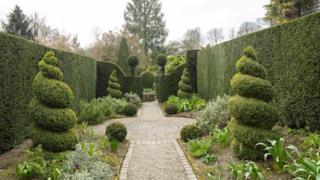 Image copyright
Image copyright
Historic England
York Gate Garden in Leeds was created by Sybil and Frederick Spencer and their son Robin between the 1950s and 1980s as an Arts and Crafts-style garden for a small suburban setting
A memorial landscape for President John F Kennedy and green-fingered pioneer Beth Chatto’s garden are among 20 post-war landscapes to receive protected status.
Historic England worked with the Gardens Trust over three years to draw up the list, which includes housing estate grounds and industrial sites.
The trust’s president, Dominic Cole, said 20th Century landscapes “have often been overlooked and undervalued”.
A playground slide and a suburban Leeds garden also received Grade II listing.
Table Of Contents
- 1 Beth Chatto Gardens, Elmstead Market, Essex
- 2 Kennedy Memorial landscape, Runnymede, Surrey
- 3 Brunel Estate, Paddington, London
- 4 Cummins Engine Factory, Darlington
- 5 Harlow Town Park, Essex
- 6 Alexandra Road Park, Camden, London
- 7 St Catherine’s College, Oxford
- 8 Former Cadbury factory, Moreton, Wirral
- 9 Shute House, Shaftesbury, Dorset
Beth Chatto Gardens, Elmstead Market, Essex
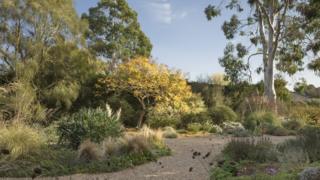 Image copyright
Image copyright
Historic England
Beth Chatto transformed seven acres of wilderness, creating a linked design to suit contrasting dry and water-logged soils
Beth Chatto created her garden from the 1960s until the early 21st Century.
She was an advocate of using plants that worked in harmony with local conditions.
Her “right plant, right place” philosophy was seen as radical at the time, but continues to shape gardening today.
Kennedy Memorial landscape, Runnymede, Surrey
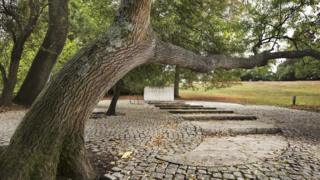 Image copyright
Image copyright
Historic England
Jellicoe created a steep climb up a flight of 50 steps to a stone monument inscribed with a quote from President Kennedy’s inaugural address
The memorial garden was designed by Britain’s best-known post-war landscape architect, Sir Geoffrey Jellicoe, between 1964 and 1965.
It was created for the British government and the Kennedy Memorial Trust as a memorial to President John F Kennedy, who was assassinated in November 1963.
The design uses the existing landscape at Runnymead, which is associated with the signing of the Magna Carta and the development of democratic government.
Brunel Estate, Paddington, London
 Image copyright
Image copyright
Chris Redgrave/Historic England
This “rare surviving example” of a 1970s play structure was designed to encourage adventurous play
Very few items of play equipment have ever been listed, but Historic England said the slide was a “particularly ambitious and inventive creation”.
It is part of a scheme for the Brunel Estate created in 1970 by Michael Brown, a leading landscape architect of the era.
He created red-brick paths and added mature trees to give the estate a sense of permanence.
Cummins Engine Factory, Darlington
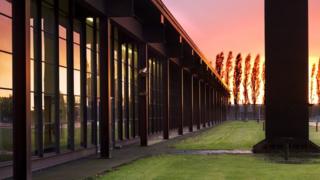 Image copyright
Image copyright
Historic England
The landscape was designed to complement the main building, which is also listed
Dan Kiley is considered the father of modern landscape architecture in the United States.
He was commissioned to design the landscape between 1964 and 1966 using three principle elements – trees, water and grass.
Harlow Town Park, Essex
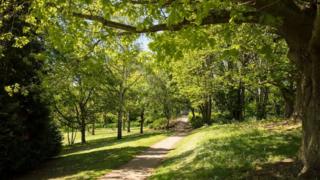 Image copyright
Image copyright
Historic England
Harlow Town Park was designed between 1949 to 1953 to complement the new town.
It was planned by architect Sir Frederick Gibberd and landscape architect Dame Sylvia Crowe, while detailed designs were created by John St Bodfan Gruffydd and engineer and surveyor AWR Webb.
The park includes formal gardens, footpaths and a bandstand, but also incorporates existing landscape features including watercress beds.
Alexandra Road Park, Camden, London
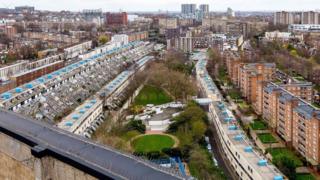 Image copyright
Image copyright
Historic England
The garden features a raised woodland walk, walled and sunken play areas and open spaces
This garden is considered internationally significant because it is rare to have a formal sculpted landscape within a modern housing estate.
Alexandra Road Estate was the first post-war public housing to be listed in 1993.
The park, created in collaboration between the estate’s architect Neave Brown and landscape architect Janet Jack, is at the heart of the project.
St Catherine’s College, Oxford
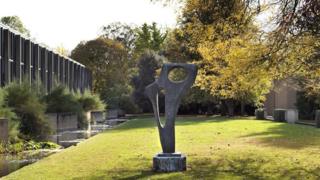 Image copyright
Image copyright
Historic England
The landscape and buildings were designed as a whole by Arne Jacobsen – his only completed commission in England
St Catherine’s College landscape was created as part of a comprehensive plan with its buildings by Arne Jacobsen, one of the foremost architects and designers of the mid-20th Century.
The long central garden uses yew hedges and walls to create “rooms” for studying and socialising.
The landscape was initially listed in 1998 and has been upgraded to Grade I.
Former Cadbury factory, Moreton, Wirral
 Image copyright
Image copyright
Historic England
The design incorporates a series of weirs or cascades which were intended to “delight passing workers”
Sir Geoffrey Jellicoe created the watercourse at the former Cadbury factory at Moreton in the 1950s.
Its innovative design incorporates a series of weirs or cascades on a site.
Duncan Wilson, chief executive of Historic England, said they were intended to “delight passing workers”.
Shute House, Shaftesbury, Dorset
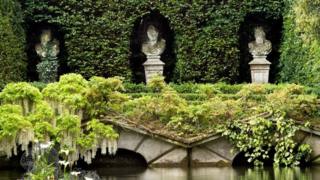 Image copyright
Image copyright
Historic England
The private garden is based around a natural spring
This private garden was also designed by Sir Geoffrey Jellicoe and is considered to be his greatest design.
He worked on it in stages, between 1969 and 1988 and again in the 1990s.
The garden is based around a natural spring, with ponds and formal and woodland areas.
Other post-war landscapes which have been listed include:
- York Gate Garden, Leeds
- Water Gardens, Burwood Place, Edgware Road, London
- Churchill Gardens Estate, Pimlico, London
- Alton East & Alton West, Roehampton, London
- Roper’s Garden, Cheyne Walk, Chelsea, London
- Campbell Park, Milton Keynes, Buckinghamshire
- Fieldend, Twickenham, Middlesex
- The Improvement Garden at Stockwood Park, Luton, Bedfordshire
- Broadwater Park, Denham, Buckinghamshire
.